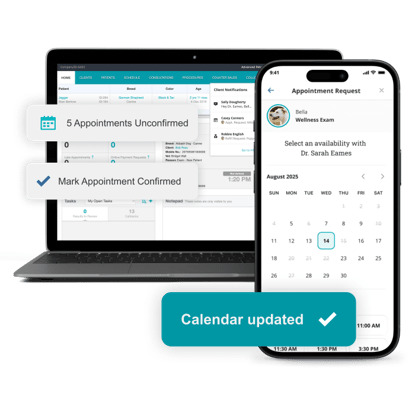Client-Focused Veterinary Care: Enhancing the Pet Owner Experience

For most pet owners, delivering exceptional pet care is not enough—they also want an outstanding client experience. However, two clients may view similar experiences through two different lenses colored by personal perceptions and the services and value provided by the hospital’s team. Client-focused veterinary care is a management style that recognizes the pet owner’s value and focuses on improving perceptions and hospital performance to strengthen the client-practice bond.
Building relationships in client-focused veterinary care
Strong relationships are the foundation of a thriving veterinary practice. Clients must feel connected to the veterinary team to trust their recommendations, follow treatment plans, and return for future care. Like our canine friends, people are a social species wired to look for connections, which can make or break mutual client and veterinary team experiences.
Teams should strive to establish deep connections with all clients, who are all valued members of your practice community. Honesty, empathy, and professionalism are key in communicating pet health needs, but conversations shouldn’t always be all business. Spend time socializing and catching up with each client in exam rooms, which will help you feel more connected.
Value perception in client-focused veterinary care
A recent AVMA survey found that 40% of clients dissatisfied with service value wanted to switch practices, but only 18% dissatisfied with convenience (e.g., hours) considered switching. A client’s value perception can color entire experiences and influence their likelihood of re-visits. Clients who don’t recognize service value won’t feel a strong bond with the practice and may not return. The veterinary team should work to educate clients about pet health needs and convey their service values to promote positive client perceptions.
Best practices for client-focused veterinary care
Veterinary teams can deepen client relationships and create positive value perceptions with these strategies:
1. Clear communication — Veterinary teams and pet owners may speak different languages in exam rooms. Team members may feel that they clearly explained a concept or procedure, but pet owners can be confused by medical jargon or too intimidated to ask for clarification. Take time to explain procedures, encourage questions, and provide educational resources to demystify care recommendations.
2. Personalized interactions — Moving too quickly through appointments and avoiding personal interaction can leave clients feeling like they are part of an assembly line. Acknowledge them by name, ask about their pets, hobbies, or human families, and find a shared interest to create a genuine connection. Talking through exam findings and involving clients during visits can help you provide more personalized recommendations.
3. Conflict resolution — Client interactions can sometimes lead to dissatisfaction or conflict because, at day’s end, we're all human. All team members should be trained in reflective listening to ensure an upset client feels heard, and in addressing clients with empathy. How you handle a client conflict can influence whether that client returns and the quality of your relationship moving forward.
4. Consistent follow-up — Reaching out after visits with a personal note checking on a pet's progress, sending educational materials, or offering to answer questions shows you are committed to client-focused veterinary care and keeps clients engaged. Veterinary technicians often excel in follow-up communications and can help reduce the veterinarian’s communication workload and broaden the client’s practice connections.
5. Continuous education — Clients don’t know what they don’t know. As veterinary professionals, your job is to eliminate knowledge gaps and help pet owners understand their pet’s ongoing health needs. Workshops, handouts, in-person discussions, and online resources help clients see the value in your recommendations.
How software influences the client experience
Another critical aspect of the client-focused veterinary care approach is using technology to boost convenience and streamline care delivery. Cloud-based veterinary software and client engagement platforms can transform the client experience with easy access to communication, online booking, pet health records, and automated reminders. Integrated telemedicine gives busy clients more ways to seek care and can help forge more robust veterinary-client-patient relationships.
Client-focused veterinary care is about building lasting relationships and enhancing the perceived value of services. Veterinary medicine is fueled by relationships and feelings, which can make or break the team and practice success. Clear communication, personalized interactions with a human touch, and technology can help your veterinary practice impress clients and build lifetime loyalty.




